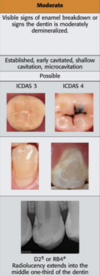FINAL EXAM Flashcards
(33 cards)
describe dental caries lesions
- lesions that occur due to activity within plaque that covers a tooth
- considered signs and symptoms of metabolisms within plaque
- can occur on enamel, dentin, or cementum
in the formation of dental caries lesions, the ___ is left undisturbed for a period of time on any tooth surface, causing the potential for a ___ to form
- biofilm (plaque)
- caries lesion
what is the best definition of dental caries lesions?
a multifactorial process of demineralization and concurrent remineralization, and is often reversible
describe dental plaque
- a biofilm (a natural, physiological process)
- an active community of microorganisms that work together
- if left on a tooth too long, it will make a white, chalky lesion on the tooth
what is the multifactorial model of the caries process?

what are the host factors that contribute to caries lesions
- tooth anatomy, texture of surface, protected surfaces
- salivary flow rates
- salivary quality and buffering capacity
- systemic disease
what are the environmental factors that contribute to caries lesions
- diet: including fermentable carbohydrates, frequency of meals, acidity of meals
- oral hygiene and compliance
- fluoride exposure
what are the bacterial factors that contribute to caries lesions?
- streptococcus: mutans ans sobrinus
- lactobacilli
- other non-cariogenic bacteria can become cariogenic for short periods of time under certain conditions
describe strep mutans
- gram positive organism
- peptidoglycan layer in cell wall
- primary causative agent in the formation of dental cavities
- metabolizes sucrose to lactic acid
describe enamel after eruption
- once erupted, enamel is in dynamic transformation
- teeth slowly erupt, therefore enamel undergoes subclinical changes, due to exposure to oral microbes, and salivary minerals
- once fully erupted into occlusion, enamel is also subjected to mechanical modifications
what is the origin of dentin?
mesodermal
what is the composition of dentin?
- 75% inorganic
- 20% organic
- 5% water
dentin has ___ mechanisms and works in concert with ___
- reparative (odontoblasts)
- pulp (dentino-pulpal organ)
what is the composition of enamel?
- 95% mineral
- 5% water
what is dentin?
- living tissue made up of tubules, each of which contain an odontoblast
- is a series of tubules extending from pulp to the DEJ, which are widest at the pulp and hardest at the DEJ
- 1/5 as hard as enamel
how are caries lesions classified?
- according to their anatomical site
- pit and fissure (common on occlusal), smooth surface (enamel caries, root caries)
- cavitated vs. non-cavitated
- activity level
- active vs. inactive
- primary (lesions on natural, intact tooth surfaces) vs. secondary (recurrent, adjacent to a filling/restoration - same etiology as primary caries) vs. residual (demineralized tissue that has been left behind before a filling is placed)
compare treatment of active vs. inactive lesions
- inactive lesions do not require any restorative action because the caries process has been arrested
- if active, steps should be taken to influence the metabolic activities and possibly the ecological balance in the biofilm in favor of arrest rather than further demineralization
what are the disease causing factors of the caries balance?
BAD disease-causing factors include the following:
- Bad bacteria - acid-producing bad bacteria
- Absence of saliva
- Dietary habits (poor) - frequent sugars and acids lead to demineralization and a low pH, allowing bad bacteria to thrive, starting the decay process
what are the protective factors of the caries balance?
SAFE protective factors include the following:
- Saliva and sealants - saliva neutralizes acid, encouraging good bacteria to thrive and aids remineralization. sealants seal the chewing surfaces of the teeth most susceptible to decay.
- Antimicrobials - helping rid the bad bacteria and establish health-promoting bacteria
- Fluoride - strengthening the tooth surfaces against demineralization, promoting remineralization
- Effective (healthy) diet
what are the functions of saliva relative to the teeth?

what are the functions of saliva relative to food?

what are the functions of saliva relative to microbes?

describe how dental biofilms are formed
- pellicle formation - minutes to hours
- attachment of a single bacterial cell - 0-24 hours
- growth of attached bacteria leading to the formation of distinct microcolonies - 4-24 hours
- microbial succession (and coadhesion) - leads to increased species diversity and continued growth of microcolonies
- climax community/mature biofilm - >/= 1 week
describe the ADA classification of a sound tooth






